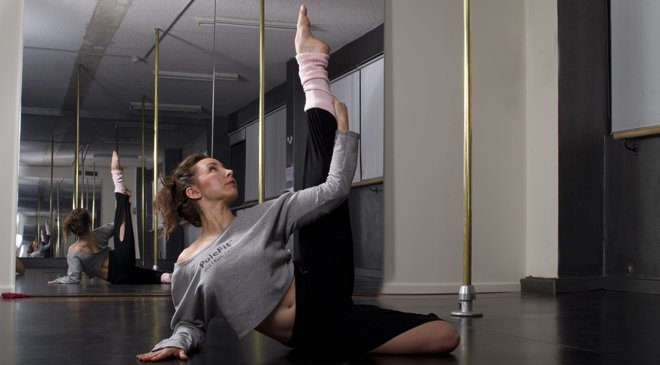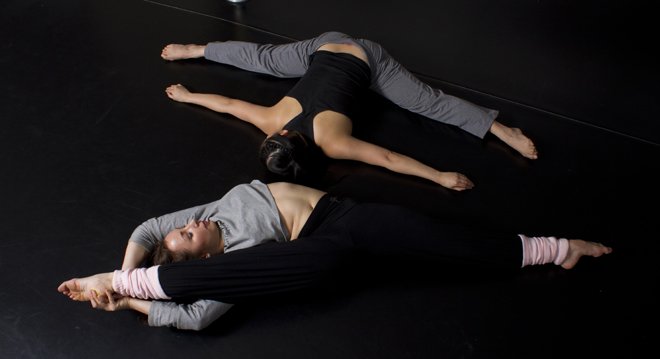Stretching is so, so important and is often an area that is over-looked by people looking to improve their fitness levels. Stretching helps to increase your flexibility, and can work to counteract the muscle tension that happens when you build up your muscles, making you less prone to injury. So I'm really excited to share this post with you today! All credit for the words and photos below this paragraph go to Studio Verve.

Increasing one’s flexibility is not usually a focus for people looking to improve their fitness levels but the importance of stretching should not be underestimated. The thought of ‘stretching’ can be a daunting idea especially for the absolute beginner for example where does one start, what does one do and for how long are often the questions milling around our heads.
In a regular 1 hour exercise session, the total stretching time normally lasts for about 5 minutes. This is usually because it is part of a warm up routine designed to prepare the body for the activity that follows. The intention is to increase your heart, raise your core body temperature and lubricate your joints for easier mobility.
Stretching to warm up our body for action and stretching to specifically increase our general flexibility are two very different things. To increase flexibility takes time and care, and cannot be achieved from 5 minutes of stretching during a class warm-up.
DID YOU KNOW THERE ARE DIFFERENT STRETCHING TECHNIQUES?
The four major types of stretches are:
1. Static Stretching: The Static stretch is used most often; this involves stretching a particular muscle or group of muscles by slowly moving the body into position and then holding the stretch for a set amount of time.
2. PNF: Proprioceptive Neuromuscular Facilitation (PNF) is a more advanced form of flexibility training that involves both the stretching and contraction of the muscle group being targeted. PNF stretching was originally developed as a form of rehabilitation, and to that effect is very effective. It is also excellent for targeting specific muscle groups, and as well as increasing flexibility it also improves muscular strength.
3. Dynamic Stretching: Dynamic stretching means a stretch is performed by moving through a challenging but comfortable range of motion repeatedly, usually 10 to 12 times. Dynamic stretching requires more thoughtful coordination than static stretching because of the movement involved. Dynamic stretching is controlled, smooth, and deliberate and should not be confused with old-fashioned Ballistic stretching.
4. Active Stretching: Active stretching means you’re lengthening a muscle by actively contracting the muscle in opposition to the one you’re stretching. This method requires you to relax the muscle you’re trying to stretch and rely on the opposing muscle to initiate the stretch. Active stretching can be challenging because of the muscular force required to generate the stretch but is generally considered lower risk because you are controlling the stretch force with your own strength rather than an external force.
HOW OFTEN, HOW LONG AND WHEN SHOULD I NOTICE A DIFFERENCE?
Consistency is key here! You should incorporate only two to four heavier stretching sessions in each week and have a lighter stretching day in between each of the heavier days.
Studies have found that range of motion can be increased by a single 15-30 seconds stretch for each muscle group per day.
Physical changes will become noticeable between four to eight weeks. The long-term effects of stretching towards increased range of motion show that after 6 weeks, people who stretched for 30 seconds per muscle each day increased their range of motion much more than those who stretched for 15 seconds per day.

SOME USEFUL TIPS TO CONSIDER WHEN STRETCHING
Breathe
Never hold your breath! This will only tense your muscles and inadvertently counteract what you are trying to achieve. Take deep, steady inhales and exhales.
Never hold your breath! This will only tense your muscles and inadvertently counteract what you are trying to achieve. Take deep, steady inhales and exhales.
Alignment
If you can’t feel the stretch then there’s a good chance you may not be in the ideal alignment. A slight adjustment and boom you’ve found the sweet spot!
If you can’t feel the stretch then there’s a good chance you may not be in the ideal alignment. A slight adjustment and boom you’ve found the sweet spot!
Relax
It’s so easy to tense up, particularly when you’re trying to avoid pain but you need to relax to get the most out of your stretch session.
It’s so easy to tense up, particularly when you’re trying to avoid pain but you need to relax to get the most out of your stretch session.
Steady and gradual does it
Respect your body! Focus on the benefits of stretching rather than taking a no pain, no gain approach. This will make your practice more enjoyable and almost meditative. Know your limits, be mindful of pre-existing injuries and ask if you’re unsure of anything. With passion, commitment and safe practice, you’ll increase your flexibility in no time.
Respect your body! Focus on the benefits of stretching rather than taking a no pain, no gain approach. This will make your practice more enjoyable and almost meditative. Know your limits, be mindful of pre-existing injuries and ask if you’re unsure of anything. With passion, commitment and safe practice, you’ll increase your flexibility in no time.
If you're super brand new to stretching, maybe attending a stretch class would be beneficial for you. Yoga is a great way for beginners to start out with stretching, or you could attend a dedicated stretch class. Many dance schools have them (including Studio Verve!) and a lot of the time you can take stretch classes independent of being a dance student.
How often do you stretch? Are you habitual with it or is it something you need to work on?

Twitter | Youtube | Instagram | Pinterest | Bloglovin
